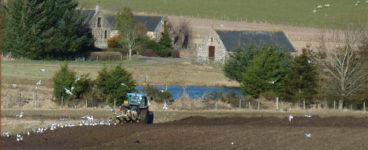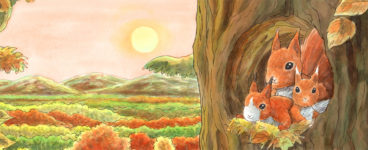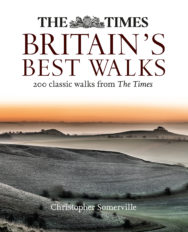‘Rocks along the path were inscribed with a phrase from a Sorley MacLean poem: “I saw the little tree rising, in its branches the jewelled music” — and that fitted the growing trees, the flower-starred banks and the exuberant singing of chaffinches, meadow pipits and skylarks.’
Christopher Somerville has covered the length and breadth of the UK on foot, and has written and broadcast about its history, landscape, wildlife and people for over 25 years. Now, in this extensive new volume, he selects his top 200 routes from his hugely popular Times column, ‘A Good Walk’.
More than just a basic guidebook, this is a meditation on our relationship with the landscape and a celebration of all that Britain has to offer. From Cornwall to Shetland via Pembrokeshire and Barrowdale, this is the most comprehensive collection of walks in the United Kingdom available in one book, and features trails to suit all skill levels and references, whether you want a gentle ramble to the pub or something much more challenging. Featuring stunning photography and using Christopher’s trademark with and lyricism, this is the perfect gift for ramblers anywhere.
Extract from The Times Britain’s Best Walks
By Christopher Somerville
Published by HarperCollins
Creag Meagaidh Nature Reserve, Highland
Start & finish: Creag Meagaidh NNR car park, PH20 1BX (OS ref NN483873)
Walk (8½ miles, moderate, OS Explorer 401): From car park follow red trail (otter symbol). In 500m pass to right of toilets/buildings (479876). Follow path on the level, then up steps; fork right at top (474879; ‘Coire Ardair’)
Long-horned Highland cattle put their heads up from the lush grazing in the floor of Aberarder Forest to peer through their luxuriant fringes and watch us go by.
We were heading for one of the most fascinating nature reserves in Scotland. Creag Meagaidh National Nature Reserve, centred around the great sombre cliffs and corries of the Creag Meagaidh range, has embarked on an ambitious programme to encourage the recolonisation of this rugged mountain landscape by the native flora and fauna that have been destroyed by overgrazing, deforestation and other manifestations of the heavy hand of man.
We walked a rising path through woods of young birch, oak and alder, free to grow now that the sheep have been removed and the deer controlled. The boggy hill slopes were a silent riot of wood cranesbill’s purple-blue flowers, intensely blue milkwort, stubby white heath spotted orchids, the yellow Maltese crosses of tormentil, and the roll-edged leaves of insect-eating butterwort in lime-green sprays.
Rocks along the path were inscribed with a phrase from a Sorley MacLean poem: “I saw the little tree rising, in its branches the jewelled music” — and that fitted the growing trees, the flower-starred banks and the exuberant singing of chaffinches, meadow pipits and skylarks.
A tiny brown frog bounced away as we brushed against the sprig of heather he was using as a springboard. At the top of the rise the path left the trees and curved west across open moorland tufted with bog cotton. Below in the glen the Allt Coire Ardair snaked and sparkled in its rocky bed. Northwards rose the flattened pyramid head of Coire a’ Chriochairein, and round in the west hung the high, rubble-filled notch called The Window that marks the northern edge of cliff-hung Coire Ardair. A lichened rock lay by the way, the parallel lines in its flat surface gouged out 10 000 years ago by the glacier that formed the precipitous glen.
The top of the glen was blocked by a low barrier of heath and grass, concealing the moraine or mass of rock and rubble that the head of the glacier had pushed before it up the valley, like dust before a broom. From its ridge we looked down to Lochan a’ Choire, suddenly revealed like a conjurer’s trick — a little glass-still lake under black, snow-streaked cliffs.
I ran down and scampered a quick, slip-and-slide circuit of the lochan. Then we sat on a ledge of mica-sparkling rock and ate our sandwiches to the glide and plop of small fish — Arctic char, residents of Lochan a’ Choire since they were isolated up here in the great melt at the end of the last glaciation. May they thrive another 10,000 years in this most beautiful mountain nature reserve.
The Times Britain’s Best Walks: 200 classic walks from The Times by Christopher Somerville is out now published by Harper Collins priced in various formats.
ALSO IN THIS ISSUE

 The Landscape Below
The Landscape Below
“I’ve spent time in my career developing simple methods to observe soil and to learn from it. When I …

 The Irresistible Charm of Scottish Nature
The Irresistible Charm of Scottish Nature
“From the Highlands to the islands Scotland is rich in stunning fauna and flora. Children’s author L …













